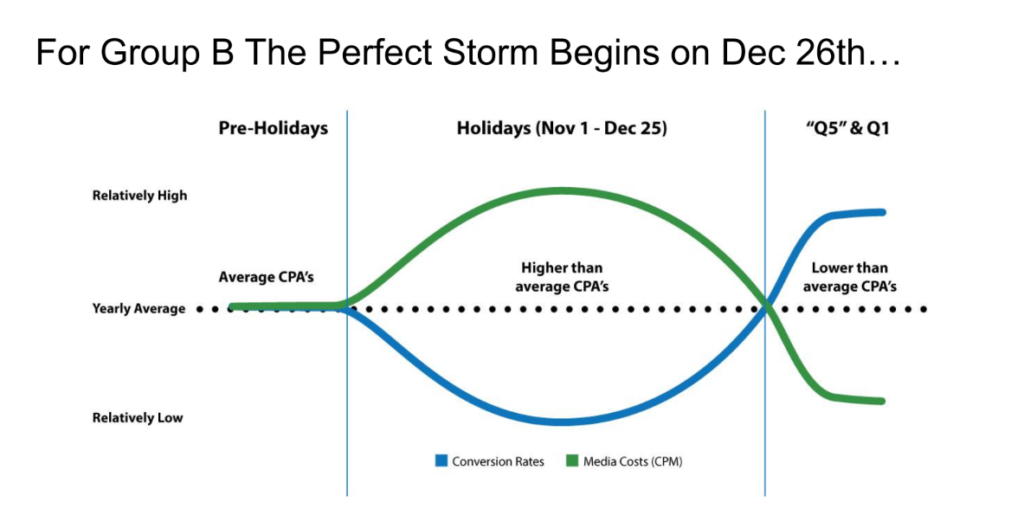How to Maximize ROAS by Strategically Timing Your Media Buys

“Know when to spend and when to hold back:” It may sound like a no-brainer, but many advertisers still fail to take the dynamics of the market into account, which can quickly tank their profits. Successful media buying requires an often tricky balance of planning and agility — but when done correctly, it’s completely game-changing for your bottom line.
A deep familiarity with your niche’s competitive spending landscape, supported by a paid media strategy that’s ready to flip on a dime, is a key ingredient to long term paid media success. So…what should you be doing to reach this ideal balance? And even more importantly, what should you avoid?
Identify When The Economics Are In Your Favor
First, timing is huge. Everything, ultimately, comes down to being able to increase the size of your media buys when response rates (CVR, click through rate, etc.) are high and media costs are low. Essentially, a low buy-in with a high projected reward means it’s time to throw your budget behind the opportunity. Conversely, knowing when to “take cover” — to scale down spending when response rates are low and media costs are super competitive — is the other part of the timing puzzle on which profits hinge.
Q4 (especially black friday and cyber monday) promotional ad spending provides an excellent example of these dynamics at play. In Q4, there are two types of advertisers: Group A, who’s selling giftable products, and Group B, who is not. Of course, this makes sense in context.

Gift-focused spending thrives right up until Christmas, and Group A companies are able to make big holiday offers… which, in turn, tends to lead to higher conversion rates. This means that Group A can bid much higher on paid media during the holidays: bad news for Group B, whose conversion rates just can’t compete, despite conventional wisdom to spend big before the holidays.
But that’s not the full story for Q4: As soon as Christmas day passes (think December 26th), Group B companies (like health & wellness brands, for example) start to pick back up dramatically. People are beginning to transition back to buying for themselves rather than others and really focusing on those New Year’s resolutions.
Of course, no one’s putting weight loss supplements under the Christmas tree. But come December 26th, the acquisition opportunities for that same wellness brand are abundant. When this post-Christmas flip occurs, Group B typically sees media costs drop 20% or more, which means much lower cost per acquisition — expected, but still the perfect storm of scaling opportunity.

For this wellness brand, “taking cover” means lowering ad spend in Q4, regrouping, and getting strategically prepped for Q1: when economics flip and a high paid media investment will actually yield much higher profits.
Another calendar-based catalyst for these spikes in ad spending? Presidential elections. Every four years, media costs reliably increase from early October until early November, and predictably ease up after election day — a critical reminder that annual/seasonal trends aren’t the only routine events your spending strategy should be planned around.
Seize The Low CPAs (Hint: Sometimes They Arise When You Least Expect Them)
Of course, there are always exceptions to patterns — and with an experienced and responsive paid media strategy, seizing these “exceptions” can make all the difference.
The obvious “exceptional” circumstance of the last few years? COVID-19. An unplanned boon for wellness brands and others that could offer a small sense of security around fortifying your body however you can (remember the home gym scramble?).
In a more surprising turn, however, some advertising giants like Coca Cola halted advertising all together — for the first time in decades. This is a great example of a totally unforeseen outcome of what was already a pretty exceptional market circumstance.
When massive brands suddenly pull out of the market, it drops bids for auction-based media significantly, meaning ad costs for the remaining advertisers were suddenly at an unprecedented low. Another game-changing opportunity for direct response advertisers with an intelligent paid media strategy — if they’re willing to adopt an agile approach.
And while COVID-style, total-global-shakeup events are thankfully quite rare, smaller-scale “exceptions” often crop up in the form of weather events (blizzards = higher ad engagement & lower media costs), viral trends (the latest social media challenge? You get the idea…), and more.
Ultimately, while a predictable and well planned paid media strategy is important for every advertiser to have, it’s a strong sense of situational awareness that really pushes performance over the edge. A hybrid approach — combining reliable, calendar-based strategy and the ability to scale or take cover at the drop of a hat — is key to maximizing your media buying success.
Looking for expert strategists to handle the unknowns for you? Apply to start scaling with O’Connell Digital Media Group.
